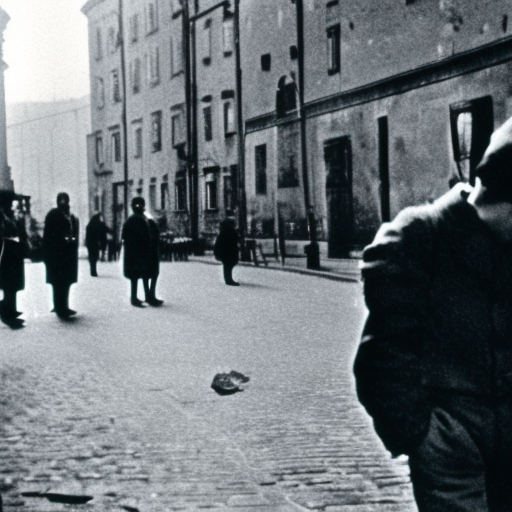Summary:
The Warsaw Ghetto Uprising was a heroic act of resistance by Jewish inhabitants of the Warsaw Ghetto against Nazi German forces during World War II. It began on April 19, 1943, and lasted for nearly a month. Despite facing overwhelming odds, the Jewish fighters demonstrated bravery and determination in their fight against oppression.
Background:
The Warsaw Ghetto was established by the Nazis in November 1940 as a segregated area in the Polish capital. Over 400,000 Jews were crammed into an area of only 1.3 square miles, suffering from extreme overcrowding, starvation, and disease. The Nazis intended to deport the inhabitants to death camps, but the Jewish community resisted these efforts.
Preparation and Planning:
The Jewish Combat Organization (ZOB) and the Jewish Military Union (ZZW) were the two main resistance groups in the Warsaw Ghetto. They realized that the Nazis planned to liquidate the ghetto and decided to take a stand. The ZOB, led by Mordechai Anielewicz, prepared for the uprising by smuggling weapons and organizing fighters.
The Uprising:
On April 19, 1943, the Nazis entered the ghetto to begin the final deportation. However, they were met with unexpected resistance from the Jewish fighters. Armed with a small number of weapons, including pistols, rifles, and homemade explosives, the fighters launched a surprise attack on the German forces. They used guerrilla tactics, including ambushes and hit-and-run attacks, to inflict casualties on the enemy.
German Response:
The German forces were initially taken aback by the resistance they encountered in the ghetto. They expected a quick and easy victory, but the Jewish fighters proved to be formidable opponents. The Nazis responded by bringing in reinforcements and heavy weaponry, including tanks and artillery. They systematically destroyed buildings and used gas to flush out the fighters from their hiding places.
Heroic Resistance:
Despite being heavily outnumbered and outgunned, the Jewish fighters displayed incredible bravery and resilience. They fought from bunkers, sewers, and basements, refusing to surrender. The uprising inspired hope and defiance among the Jewish population, who had been subjected to years of persecution and dehumanization.
End of the Uprising:
After nearly a month of intense fighting, the Nazis managed to gain control of the ghetto. They systematically destroyed the remaining buildings and deported the surviving inhabitants to concentration camps. The uprising resulted in the deaths of approximately 13,000 Jews, either killed in battle or deported to extermination camps.
Legacy:
The Warsaw Ghetto Uprising remains a symbol of Jewish resistance and defiance against the Nazis. It demonstrated the indomitable spirit of the Jewish people in the face of unimaginable atrocities. The uprising also inspired other acts of resistance in ghettos and concentration camps throughout Europe.
Conclusion:
The Warsaw Ghetto Uprising was a courageous act of resistance by Jewish fighters against the Nazi regime. Despite facing overwhelming odds, the fighters demonstrated bravery and determination in their fight for freedom. The uprising serves as a testament to the strength of the human spirit and the refusal to be silenced in the face of oppression.












